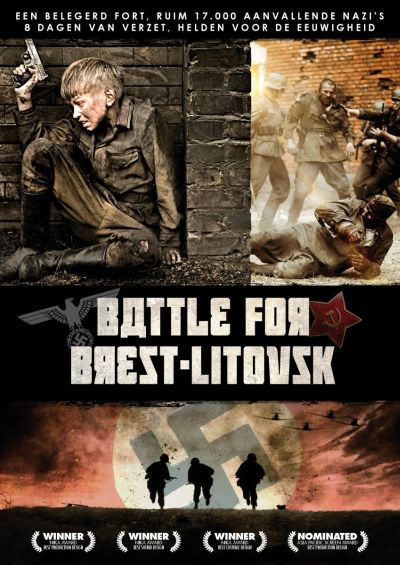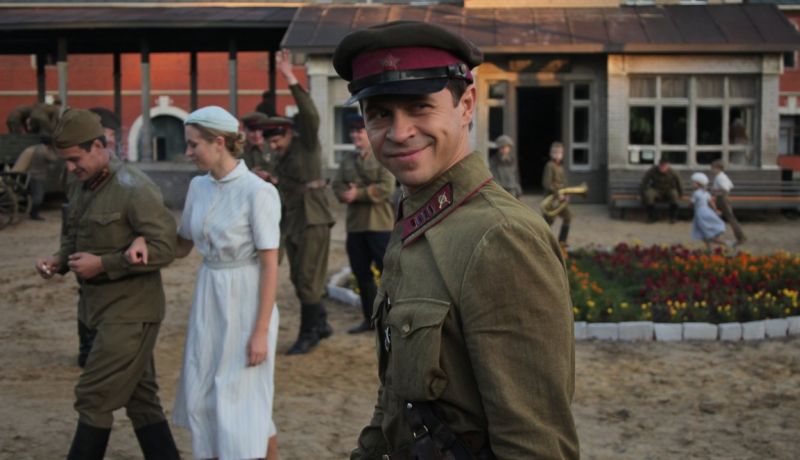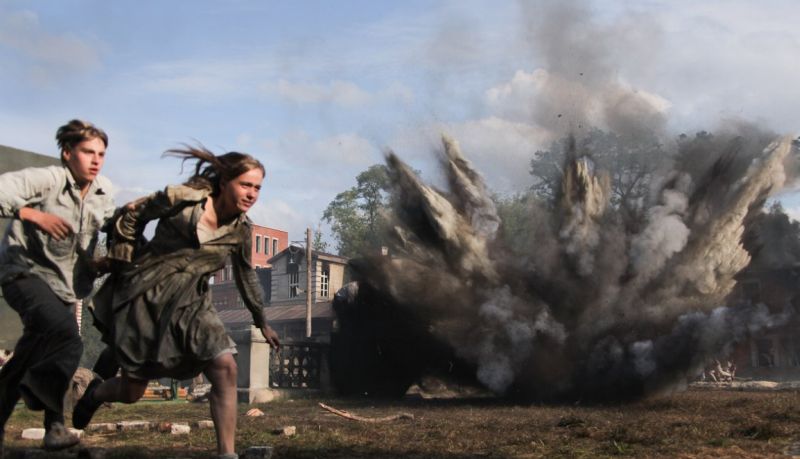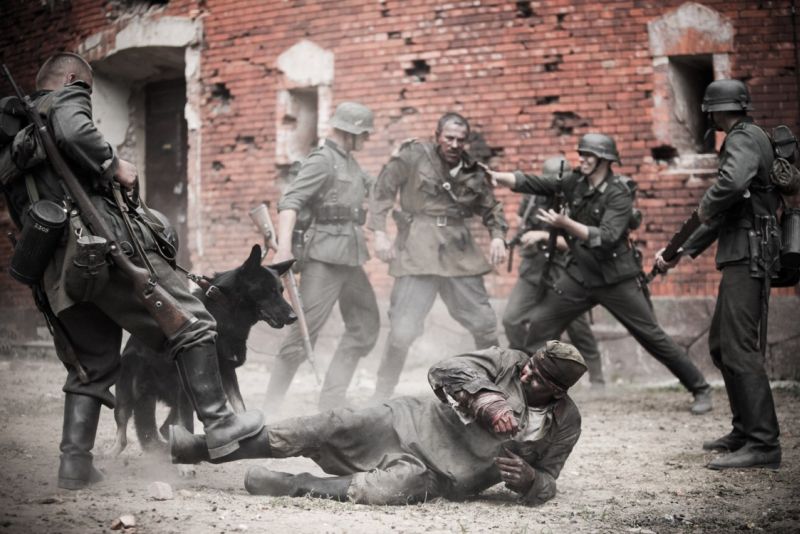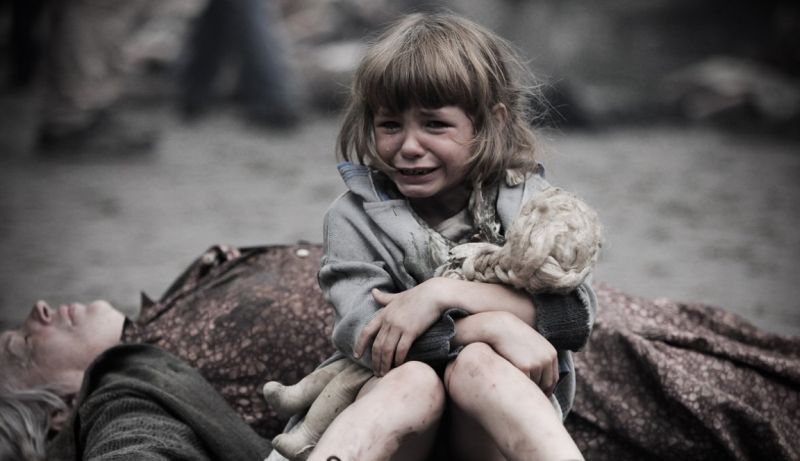Fortress at war
| Title: | Fortress of War |
| Director: | Aleksandr Kott |
| Cast: | Aleksey Kopasshov, Andrei Merzlikin, Pavel Derevyanko a.o. |
| Released: | 2010, on DVD/Blue Ray in 2015 |
| Playing time: | 133 minutes |
| Description: |
In their attack on the Soviet Union, German troops encountered an obstacle in the form of Fortress Brest, occupied by the Red Army in the Russian occupation zone of Poland. After the start of Operation Barbarossa, it took seven days before the 19th-century Russian fortification was captured by the Wehrmacht. This had taken longer than initially expected, more due to the fact the defenders were utterly taken by surprise by the attack. Despite their being heavy shelled by artillery and aerial bombardments and their supplies dwindling fast, the Soviets put up a courageous resistance against the German supremacy. Their fight in the fortress evolved into a symbol of resistance and in 1965, the fortress was given the title Hero Fortress, an honor comparable to Hero Cities like Leningrad and Stalingrad. In Soviet propaganda, the siege of the fortress has been immortalized in the form of newspaper articles, novels and plays. Sometimes however, the truth was a little tampered with, for instance letting the siege last for 32 days and omitting that a large number of Soviet soldiers had themselves taken prisoner-of-war. The movie "Bessmertnyy garnizon" (Immortal garrison) from 1957, an heroic war epic written by Soviet author and war correspondent Konstantin Simonov, was succeeded in 2010 by a Russian movie about this historical struggle entitled "Brestskaya Krepost". In the Netherlands, this movie was released with the English title "Battle for Brest-Litovsk." On the eve of the 70th birthday of the siege, the time had come for a truthful representation of this tragic story in which the heroic actions and sacrifices of the defenders of the fortress are given equal credit. Both big and little heroes have a role in the movie. A literally small hero is 15-year-old Sashka/Aleander Akimov who doubles as the teller of the story. In 1941, he is a musician in the military orchestra of the fortress. In the early morning of the German attack, he and his girl friend Anya are fishing in the moat of the fortress until suddenly bombs fall from the sky. Devoted to duty as he is, Sashka immediately returns to the fortress where he and his tuba, damaged by the rain of bombs, report for duty in the service of his country. Music does not stop the Germans and does not encourage the panicking Soviet soldiers either but the boy does prove his merits as a messenger and water bearer. Meanwhile he has lost Anya from sight but as he also feels responsible for her he starts looking for her among the smoldering debris. bodies of dead soldiers and burning buildings. At the end of the movie he has aged to an old man who pays tribute to his fallen comrades at the 105 feet tall concrete monument in memory of the defenders of the fortress, erected in 1970. The big heroes in the movie are the three important leaders of the defense: Major Pyotr Mikhailovich Gavrilov, Sovjet commissioner Efim Moiseevich Fomin and Lieutenant Andrey Mitrofanovich Kizhevatov. The three of them would be decorated for their contribution to the battle, Gavrilov and Kitzhevatov were even awarded the title Hero of the Soviet Union. Due to the absence of higher ranking officers, they each were in charge of one of the pockets of resistance in the fortress. Apart from infantry and a unit of border guards of the NKVD (Soviet secret service), there is a hospital in the fortress and family members of the soldiers also live there. Their presence turns the siege into a much larger tragedy than it already is. In the movie, we see how frightened civilians and patients hide in cellars, die in hails of shells and bullets and are being used by the Germans as a human shield. Without any supply of water, ammunition and medicine, everyone in the fortress is marked for death. Some surrender early but a heavy bomb, dropped by the Germans ends the Soviet resistance once and for all. The Red Army loses over 2,000 dead and some 6,800 men are taken prisoner-of-war against a death toll of 429 on German side. "Fortress at war" shows a gruesome image of the siege of the fortress. We do see small groups of soldiers putting up a fierce resistance but the poor preparation for an attack is clearly shown as well. Poorly armed Soviet soldiers, dressed in ragged uniforms, die like flies even without having fired a shot themselves. Equipped with tanks, a far stronger air force and bombs, the Wehrmacht causes slaughter among Soviet soldiers and civilians. At some locations in the fortress, corpses are piled up high. In a horrific scene, a German tank ploughs through bodies lying in its path, in another scene, civilians hiding in a cellar are being burned alive by a German flamethrower. The struggle is reminiscent of the epic battles for castles and ramparts in movies about the Middle Ages. All violence of weaponry is not at the cost of the horrible facts however. Apart from paying a tribute to the courageous struggle of the Red Army, "Fortress at war" is first and foremost in memory of the horrors of a war and it is just that which makes it into a convincing war movie. |
| Rating: |     (Very Good) (Very Good) |
Definitielijst
- infantry
- Foot soldiers of a given army.
- propaganda
- Often misleading information used to gain support among supporters or to gain support. Often used to accomplish ideas and political goals.
- Red Army
- Army of the Soviet Union.
- resistance
- Resistance against the enemy. Often also with armed resources.
- Soviet Union
- Soviet Russia, alternative name for the USSR.
- Wehrmacht
- German armed military forces, divided in ground forces, air force and navy.
Images
Information
- Article by:
- Kevin Prenger
- Translated by:
- Arnold Palthe
- Published on:
- 17-12-2017
- Last edit on:
- 09-06-2018
- Feedback?
- Send it!
